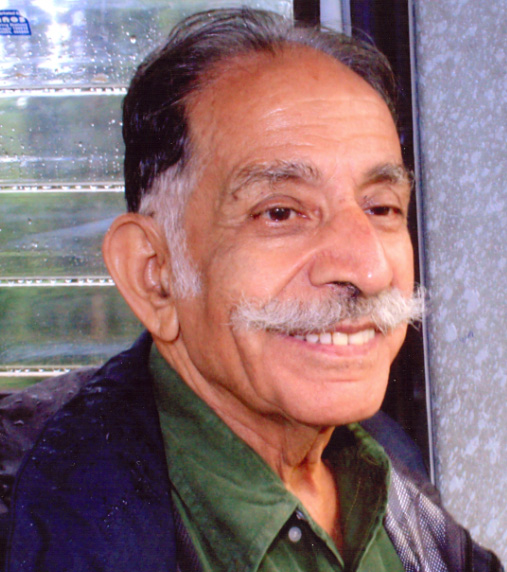The
Forgotten Tirtha of Gangodbheda
Where Saraswati appeared as Rajhansi
By M. M. Munshi
 According
to Kalhana in the three worlds the jewel producing earth is so extolled in the
region of Kubera where the Kasyapa’s land (Kasmira) is enclosed by the
father of Gauri - the Himal parbat. Where out of respect for Kasyapa the
sun does not burn fiercely during the summer as if the dwellers of the
latter’s land ought not to be tormented. To protect the Nagas who are afraid of
Garuda to seek shelter from the latter, janurdana stretched his arms high
enough in the guise of mountain walls.
According
to Kalhana in the three worlds the jewel producing earth is so extolled in the
region of Kubera where the Kasyapa’s land (Kasmira) is enclosed by the
father of Gauri - the Himal parbat. Where out of respect for Kasyapa the
sun does not burn fiercely during the summer as if the dwellers of the
latter’s land ought not to be tormented. To protect the Nagas who are afraid of
Garuda to seek shelter from the latter, janurdana stretched his arms high
enough in the guise of mountain walls.
Its rivers are free from
aquatic monsters and furnished with comfortable embankments for descending into
water, provided with warm bath houses for winter. The Country abounds with lofty
houses, saffron fields, crystal clear icy water, grapes and things which even in
Heaven are difficult to find. Filled with rows of rice fields fully thriving and
endowed with good fruits, inhabited by people who perform Yagnas and are
engaged in self study and contemplation. Virtuous sages well versed in Vedas.
It is bedecked with temples of Gods and all the holy places which exist on
earth are here. Country where Kesva (Vishnu and Isana (Shiva)
adorn as Chakrabrat and Vijaysea as well as in other forms. There
is not a space larger than a grain of sesame without a tirthas.
Here the Goddess
Saraswati is seen in the form of a Swan in a lake situated on summit of
Bhedagiri which is sanctioned as the source of Ganga.
According to Niimat
Purana by bathing in Gangodbheda (Bhedagiri) a man obtains merit of bathing in
Ganga and is honoured in heaven.
Gangodbheda Mahatmaya
States that Rishi Pulasthya while performing a long penance in the land of Sati
made Ganga gush forth from Himavat for his worship. When the Rishi Pulasthya
wanted to discharge the Ganga water after completing his worship, he was stopped
by the divine voice of Saraswati from the sky that Ganga had issued from a
mountain in Bheda forest and there wiii rise the holy Tirtha of Gangodbheda. On
top of the hill where level ground extends for only ten Dhanus a great pond will
be formed without a settu (dam) removed from the water of Torments. At its
eastern foot a stream called Abhaya (Purifier from all sins) will issue and will
maintain a uniform flow. Sarasvati’s voice further informed the sage that holy
Ganga will manifest herself in this place for one third of every month and rest
two thirds in heaven and hell. Sage Pulasthya prayed that the Ganga may rest for
eons in Bheda. His wish was granted and Tirtha of GangodBheda came into being in
order to obtain a glimpse of Goddess Saraswati the sage under took another hard
and long penance and Saraswati appeared before him in the form of a Rajhansij
(Swan).
The sage of Pulasthya
worshipped the Saraswati on ashtami and naumi of Shakul Pakash/Chaitra,
as Bheda (Yada Sadbehobhinnasi tada Bhedasi Bhamini) and again
worshipped her as Hamsavagisvani -Bheda on the Chaudshi and Poornima
of the same Paksh. Ever since the Goddess has received worship on
these four days till it faded from memory of the devout by the end of the
nineteenth Century.
A number of Smaller
tirthas intended to be visited with Gangodbheda pilgrimage include Ramusha,
Ashvama, Vaitrani etc. Gangodbheda Mahatmaya also mentions that no snow ever
falls over it for a distance of about 125 hastas. Neither the Nilmat
Purana, nor Gangodbheda Mahatamya or Rajtarangini give any indication about the
location of the Tirtha. Abu-UI-Fazal in the Mirabillia of Kashmir in
Ain-I-Akbari states that near Sukhroh is a low hill, on the summit of which
is a fountain, which flows throughout the year and is a pilgrimage for the
devout. Snow does not fall on this Spur.”
Closeness of the Tirtha
with Ramusha, modern Ramuh (Kakpura Kol), identical observations of the
Gangodbheda Mahatmaya and Abu-ul-Fazal’s account about snow not falling on the
spur together with Shrivara’s account of the defeat of Masud Khan of Rajouri at
the hands of Mohamed Shah, a descendant of Zain-ul-abdin in 1484-86 near
Drabhagrama present Dranghom and Mahsud’s retreat to Rajouri via Bhedavanapat
(Forests of Bheda) enabled M.A. Stein, historian, geographer and archaeologist
and translator of Kalhana’s Rajatarangini to locate the Tirtha of Gangodbheda
with pin point accuracy at Budbrar.
The Tirtha of Gangodbheda
also known as Bhedadevi and Bhedagiri comprising a stone lined tank with stone
steps for getting into water and remains of the surrounding wall, is situated on
a flattened portion of a North - Easterly radiating spur of Pir Panjal Range
about 60 feet above the bed of Birnai Streams a tributary of Romchu or Kakpura
kol, flowing in a north easterly direction at present called Budbrar by
Kashmiris and Bijabrari by Gujjars. It is about 20 kms south-west of the hamlet
of Drabgom and one kilometre north of Pudan hill 9387 feet in Sukru Area of
Kashmir. The Shrine is approachable from Drabgom via hill villages of Mospur and
Kilar.
The tank is about 7 sq.
meters in area with its four corners corresponding to the cardinal points with a
bubbling spring in its northern corner. According to Stein” there is an opening
on the northeastern side marked by two carved stone pillars. Originally marking
the door step and still showing the holes for the pivots on the slopes of the
hillock just below the door, and at a point corresponding to the level of water
in the tank is a spring which evidently is a natural outflow of the tank and
serves to drain its surplus water. Stein further adds that near the ruined
doorway on a huge boulder two lingas of about 20cms in height, and 30cms high
figure of an undraped lady carrying water pitchers have been carved in relief. A
figure of a male also carved in relief on detached boulder was seen by him.
On the south-east side of
the tank about 30 metres above the tank in the middle of widely separated summer
huts of Gujjars heaps of bricks and rough stones from a linear mound which also
according to Stein may have been the living quarters for purohitas
attending the Shrine or a dharamsala for pilgrims.
That the pilgrimage to
Behdadevi must have been in vogue during the sixteenth and seventeenth century
is evident from the observations of Abu-UI-Fazal. Pilgrimage to the Shrine seems
to have declined during eighteenth and early nineteenth century. The Tirtha
was forgotten even by the devout, by the end of nineteenth century, is
evident from the fact that the Kashmiri Pandits of nearby villages of Zainapura,
Shupian, Drabgram, Ramuh, and Hal-Moghulpura by 1895 were completely unaware of
the Tirtha of Gangodbheda.
An aged Gujjar camping at
Budbrar for summer grazing of his buffaloes had told Stein in 1895 that he had
seen Kashmiri Pandits visiting the Shrine during 1850’s - 60’s for worship and
Shrada but later such visits had become very rare and since 1890-91 none
had visited the Shrine.
It is very difficult to
imagine as to how a Tirtha so popular and frequently visited by pilgrims
was abandoned and ultimately faded from memory by the end of the 19th Century.
Possibly persecution of Hindus and destruction of their places of worship during
the Afghan rule 1753-1819 and hardships of the journey to an altitude of about
8500 feet in early Spring i,e Chaitra Shakul. Pakash must have resulted
in decline of pilgrimage to the ancient shrine at Budbrar in favour of an easily
accessible makeshift place of worship at Hal-Moghulpur.
Even after the
rediscovery of the ancient Shrine at Budbrar in 1895 by Stein no effort seems to
have been made by the then Dogra rulers of Kashmir, Dharmarth Trust or the
Kashmiri Pandits of the nearby villages to revive the pilgrimage.
I had an opportunity to
see the site of this ancient Tirtha in 1970 while trekking along Rajouri-
Drabgram route via Dobjan. I found that nothing much had changed since
rediscovery of the shrine by Stein in 1895 except that (1) considerable number
of bricks seemed to have been used by Gujjars in constructing their summer huts
and (2) carving of the male figure in relief on the detached boulder was not to
be found. Gujjars were still there but none of them had seen pilgrims visiting
the shrine.
The identical observation
recorded in Gangodbheda Mahatmaya and Ain-I-Akbari by Abu-Ul-Fazal (1) no snow
falls on the hill and nor (2) the popular Kashmiri belief that spring water is
warm during winter and cold in summer is scientifically feasible. The tragedy of
science has been that beautiful hypothesis have been replaced by ugly facts. In
this case the fact is that water of deep seated springs like that of Gangodbheda
maintain a constant temperature throughout the year which is higher in summer
and lower in winter than the atmospheric temperatures. During the winter, the
relative warmer temperature of the water of the Gangodbheda spring does not
allow the snow falling on the surface of the water and its immediate vicinity to
accumulate.
Nothing is known to me
about the present status of the shrine as I did not get another chance to visit
the site after 1970 nor have I had the opportunity to meet any person who had
visited the place after 1970.
Source:
Kashmir Sentinel
















No one has commented yet. Be the first!